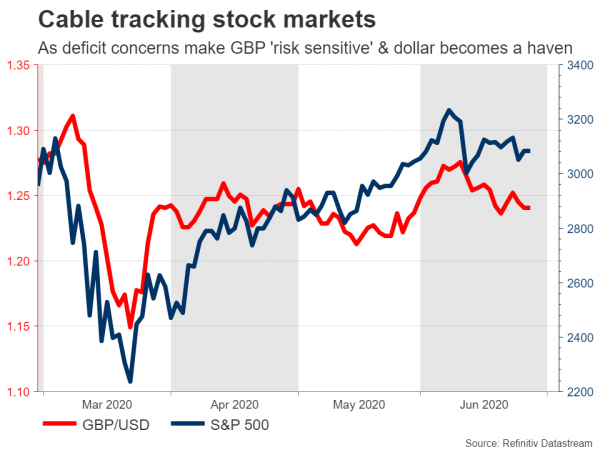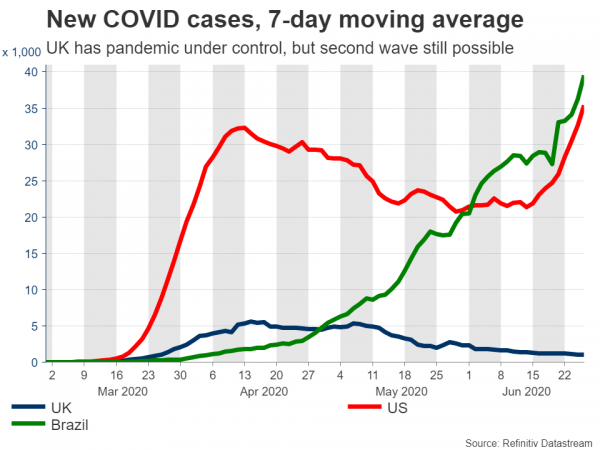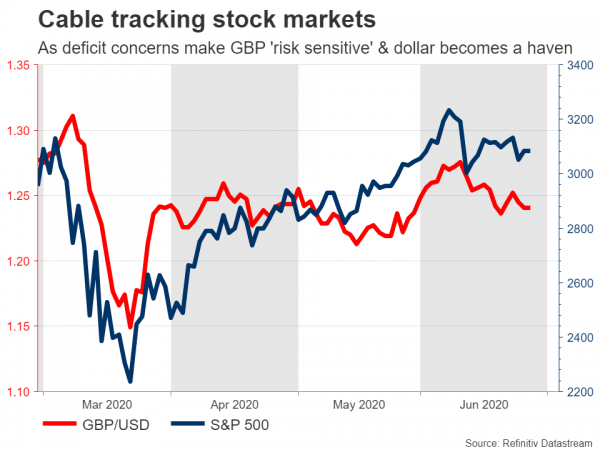The British pound has become very sensitive to changes in risk sentiment lately, with Cable transforming into a ‘risk on’ – ‘risk off’ pair whose fortunes are connected more to stock market performance than UK fundamentals. As such, a better proxy for Brexit developments in this new era may be euro/sterling. Overall, downside risks seem to outweigh upside ones for the pound right now, especially given the resurgence of infections globally and intensifying Brexit uncertainty, though a powerful rebound later in the year could follow.
The kindness of strangers
Last year, Cable used to be a good barometer for how the Brexit talks were progressing, and how the political and economic situation in the UK was evolving. That’s not the case anymore, with Cable responding more to how global risk sentiment changes than anything UK related.
Two key factors explain this shift. The first relates to Britain’s large current account deficit. When a country runs a persistent current account deficit like the UK does, it essentially means that it imports more than it exports, and it relies on capital inflows from abroad to finance the difference.
As such, the UK economy is highly exposed in times of global turmoil, when cross-border capital flows dry up. The Bank of England’s previous Governor – Mark Carney – once described it as “relying on the kindness of strangers”. Hence, when the world economy falls off a cliff, the pound usually suffers amid concerns about the UK’s ability to finance its deficits, while any signs of global recovery typically boost sterling.

The second factor has been the dollar’s transformation into a safe haven. With everyone rushing into the reserve currency’s safety every time things start looking bad, the dollar mostly moves in opposite direction to stock markets nowadays, further enabling Cable to move in the same direction as equities and risk sentiment.
But Cable not the only game in town
This implies that a better proxy for what’s happening in the UK right now may be euro/sterling, which at least doesn’t include the dollar and hence is a little less sensitive to shifts in global risk appetite. That doesn’t mean euro/sterling is immune to risk sentiment – far from it – but it might not be as sensitive as sterling/dollar.
Second wave blues
Speaking of what’s happening in the UK, the nation is taking baby steps out of its lockdown, with most shops reopening last week, though pubs and restaurants remain closed until July 4. Although Britain was quite late to go into lockdown and thus is among the last to exit, at least the government stepped up its stimulus game, providing massive assistance to businesses and individuals that could enable a stronger recovery.
The flipside is that the fiscal deficit has exploded as a result, meaning that the government now has less ‘firepower’ if it needs to act again in the future. Not only that, many are wondering whether a return to ‘belt tightening’ and austerity is imminent once the crisis ends, given the ballooning debt.
That’s a story for another time, though. For now, the pound’s path will likely be decided by how the upcoming Brexit talks play out, and whether the resurgence of infections globally continues. On the virus front, cases are surging in the United States and that has crippled risk appetite in recent days, by extension weighing on sterling.

Alas, it’s not just the US. The UK itself could be at risk of another outbreak, judging by pictures of beaches being absolutely packed with people ignoring social distancing rules amid the latest heatwave. Watch those virus numbers in a week or two.
Brexit also set to haunt sterling
With just six months to go until the Brexit transition period ends, the two sides remain far apart on key issues, most notably on UK businesses following EU regulations to ensure a ‘level playing field’. Negotiations resume next week and will continue into August, with the aim of reaching an agreement before year-end to avoid a no-deal exit.
Ultimately, chances are that some deal will be agreed, even if it’s a ‘bare bones’ one that only ensures tariffs will be avoided on physical goods. The last thing either side needs right now is a chaotic no-deal Brexit that disrupts the economic recovery.
However, it might take several months and a lot of brinkmanship before we get there. This has been a clear pattern in the talks all these years – neither side is willing to compromise until the clock is about to strike midnight and a do-or-die deadline is approaching fast. That makes sense, as it is also easier to ‘sell’ any agreement to the public if the alternative is an immediate economic catastrophe.
As such, Brexit uncertainty seems set to intensify in the coming weeks, spelling downside risks for the pound as investors price in a higher probability of a no-deal exit.
Upside risks?
What is the biggest factor that could propel sterling higher from here? It’s probably a virus vaccine being found, or at least some effective treatment. That could simultaneously boost global risk appetite, dramatically reduce the economic impact of any second waves, and calm investors’ concerns about Britain’s ability to finance its huge deficits.
The only problem left would be Brexit, and even that might take a turn for the better before year end. Unfortunately, it’s anyone’s guess when a vaccine will be developed. It could be in a few months, or next year, or even beyond.
Pain for now, relief later
All told, the risks surrounding the pound seem tilted to the downside for now, as a lack of Brexit progress combines with softer risk appetite, especially if second wave concerns intensify.
This toxic cocktail could keep the pound on the back foot over the summer before an eventual rebound later in the year, which might be powered by a Brexit breakthrough as deadlines approach in the autumn, concrete signs the global economy is recovering, and hopefully, a virus vaccine as well.


 Signal2forex.com - Best Forex robots and signals
Signal2forex.com - Best Forex robots and signals




